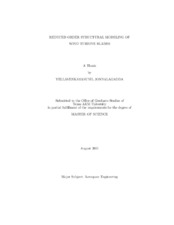Reduced Order Structural Modeling of Wind Turbine Blades
Abstract
Conventional three dimensional structural analysis methods prove to be expensive for the preliminary design of wind turbine blades. However, wind turbine blades are large slender members with complex cross sections. They can be accurately modeled using beam models. The accuracy in the predictions of the structural behavior using beam models depends on the accuracy in the prediction of their effective section properties. Several techniques were proposed in the literature for predicting the effective section properties. Most of these existing techniques have limitations because of the assumptions made in their approaches.
Two generalized beam theories, Generalized Timoshenko and Generalized Euler-Bernoulli, for the static analysis based on the principles of the simple 1D-theories are developed here. Homogenization based on the strain energy equivalence principle is employed to predict the effective properties for these generalized beam theories. Two efficient methods, Quasi-3D and Unit Cell, are developed which can accurately predict the 3D deformations in beams under the six fundamental deformation modes: extension, two shears, torsion and two flexures. These methods help in predicting the effective properties using the homogenization technique. Also they can recover the detailed 3D deformations from the predictions of 1D beam analysis.
The developed tools can analyze two types of slender members 1) slender members with invariant geometric features along the length and 2) slender members with periodically varying geometric features along the length. Several configurations were analyzed for the effective section properties and the predictions were validated using the expensive 3D analysis, strength of materials and Variational Asymptotic Beam Section Analysis (VABS). The predictions from the new tools showed excellent agreement with full 3D analysis. The predictions from the strength of materials showed disagreement in shear and torsional properties. Explanations for the same are provided recalling the assumptions made in the strength of materials approach.
Citation
Jonnalagadda, Yellavenkatasunil (2011). Reduced Order Structural Modeling of Wind Turbine Blades. Master's thesis, Texas A&M University. Available electronically from https : / /hdl .handle .net /1969 .1 /ETD -TAMU -2011 -08 -10136.


